The Google Ad Preview and Diagnosis Tool is designed to check your ads in a live setting. It allows you to view a search engine result page (SERP) to see if your ad appears. And what it looks like.
You can view a SERP for specific parameters. Like keywords, location, language, device, and audience. The tool will display your ad as it appears to users within the device mockup of your choice.
Like this:
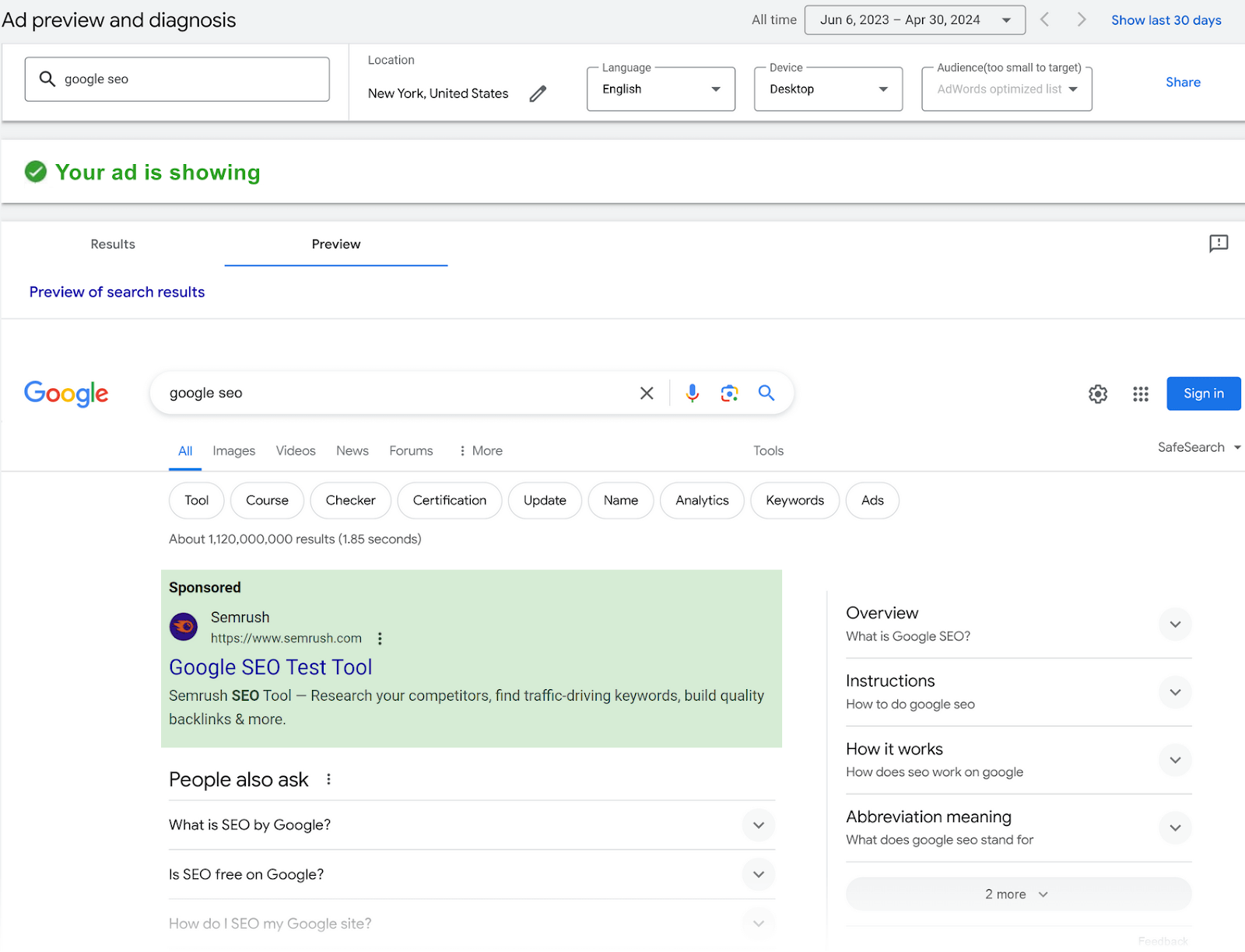
Use the Google Ad Preview Tool to see an accurate ad preview. You’ll be able to determine if your ad is running, diagnose issues, and find optimization opportunities. And make sure it looks good.
See Your Ad Without Hurting Performance
You should use this tool instead of searching for the keyword on Google. If you do this too much, you’ll trigger impressions without clicks. This lowers your click-through rate (CTR). Which may tell Google not to show your ad as much.
Eventually, you may notice a decrease in the visibility of your ads. That’s because Google may stop displaying an ad that doesn’t receive clicks. In both cases, searching for your ad can skew your performance metrics.
Diagnosing Ads Issues
If your ad isn’t running, the Google Ad Preview and Diagnosis Tool will tell you why. Some common reasons are:
- Your ad is still in review
- The keyword you chose is not in your account
- Your campaign doesn’t have a sufficient budget
- Your ad isn’t enabled
- Your daily budget has been exhausted
- The location you chose isn’t being targeted
The preview tool always displays the SERP’s current appearance. You’ll see it even if your ad is not currently running.
See How Your Ad Looks
Even though Google named this tool “Ad Preview Tool,” you’re not previewing your ad. This tool allows you to see an ad that’s already live. Use this tool to see the appearance of your ads. You can filter your SERP view by the following:
- Keyword
- Location
- Language
- Device
- Audience
You’ll only be able to see the audience filter if your campaigns target specific audiences. That filter option will not appear for campaigns with no audience targeting.
The SERP display might reveal an issue with your ad. Like truncated text or incorrect URLs. If you see an ellipsis (“…”) after your title, you may have used too many characters. Which forces Google to shorten your title on specific devices.

It’s important to note that some extensions might not appear in the ad preview tool even if they appear live.
If you use an extension like this but it’s not appearing in your ad preview, check your ad extension performance dashboard to see if they’re running.
Optimizing Ads for Better Performance
Tweak your ads for better performance based on the insights you get from the ad preview tool. For example, you might find:
- Your local ads are showing for general keywords, lowering your CTR
- An ad with the wrong message is getting to the wrong audience
- You’re showing your ad in a particular SERP, but you’re not in the No. 1 position
- Google Ads Sitelinks aren’t going to valuable pages based on the search intent
- Your ad copy is truncated and confusing
All of these are opportunities to optimize your ads for better performance.
You need a Google Ads account to use the Google Ad Preview tool. Once you have an account, you can view a SERP by selecting a few display parameters.
Login to Google Ads and Find the Ad Preview and Diagnosis Tool
Log in to your Google Ads account to use the Ad Preview and Diagnosis Tool. Once you’re logged into your account, you’ll see a dashboard with an overview of your campaign performance.
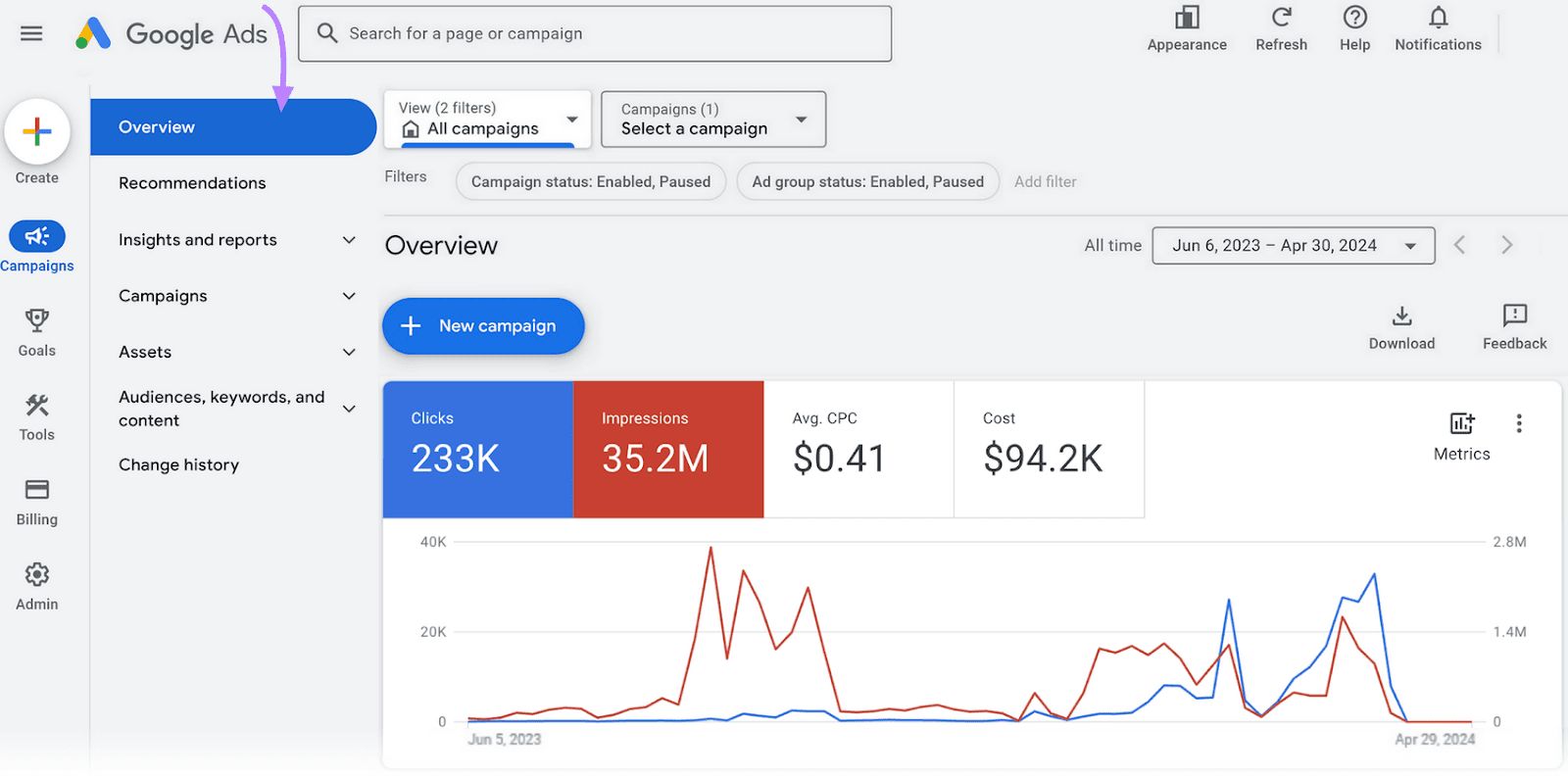
On the left-hand side of the screen, locate and click “Tools” to open a sub-menu. Select “Troubleshooting” to expand the menu, then click “Ad preview and diagnosis.”
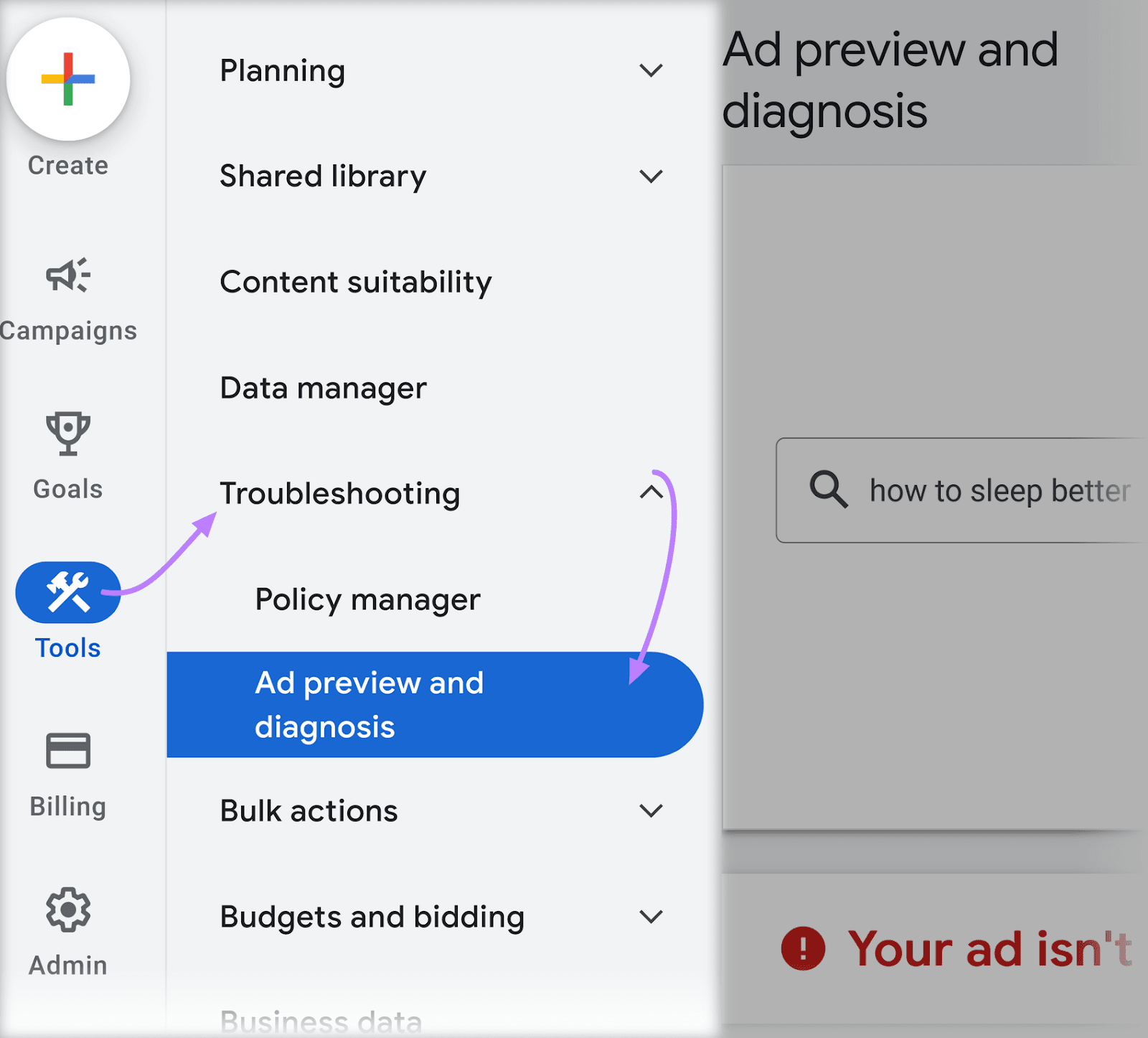
Choose Your Keyword and Filters
You need to select some SERP parameters to view your ad on a SERP. In this case, we can choose a keyword, location, language, and device. If you’re using audience targeting for your campaigns, you can also select an audience.
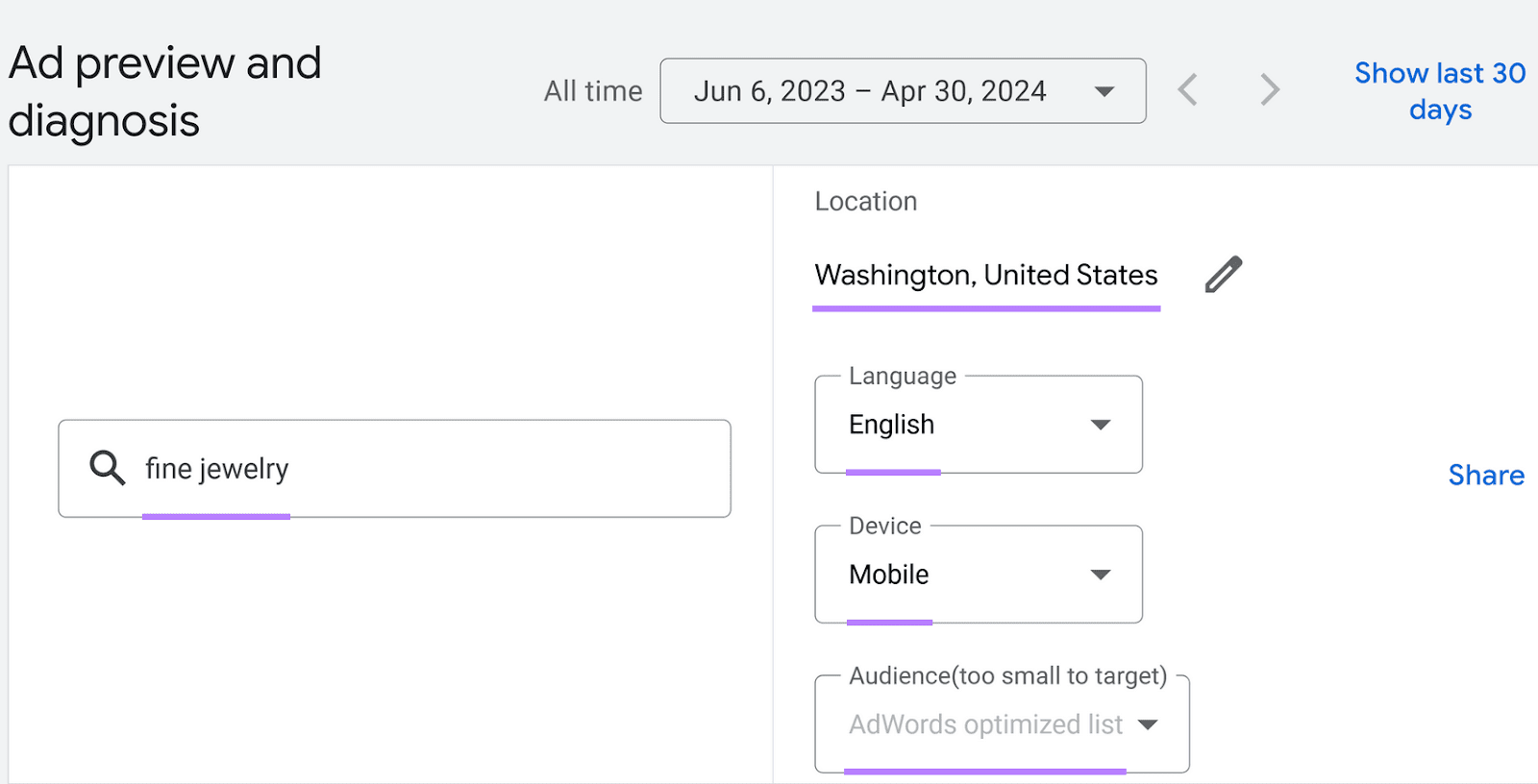
When you start to type a keyword in the search bar, the tool will suggest keywords. It recommends keywords you’re targeting by impressions and volume.
You’ll also need to search for your location. We clicked the pencil icon to the right of “Location” and started to type “Paris.” Google gave us several suggestions to select. You can choose locations that are as broad as an entire country, or as targeted as a single city.
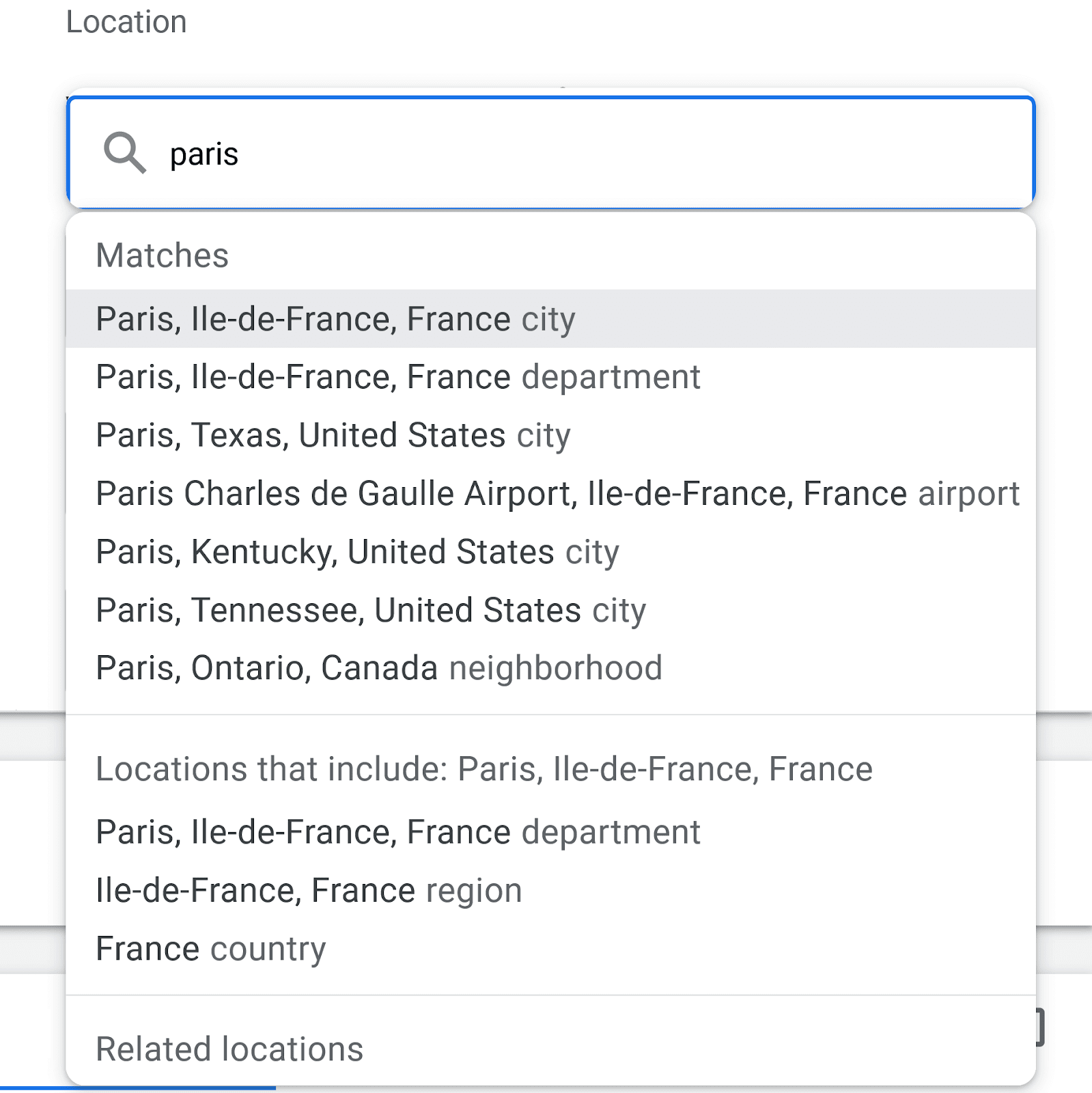
The same is true for languages. You can either select from the dropdown menu or start to type your language of choice.
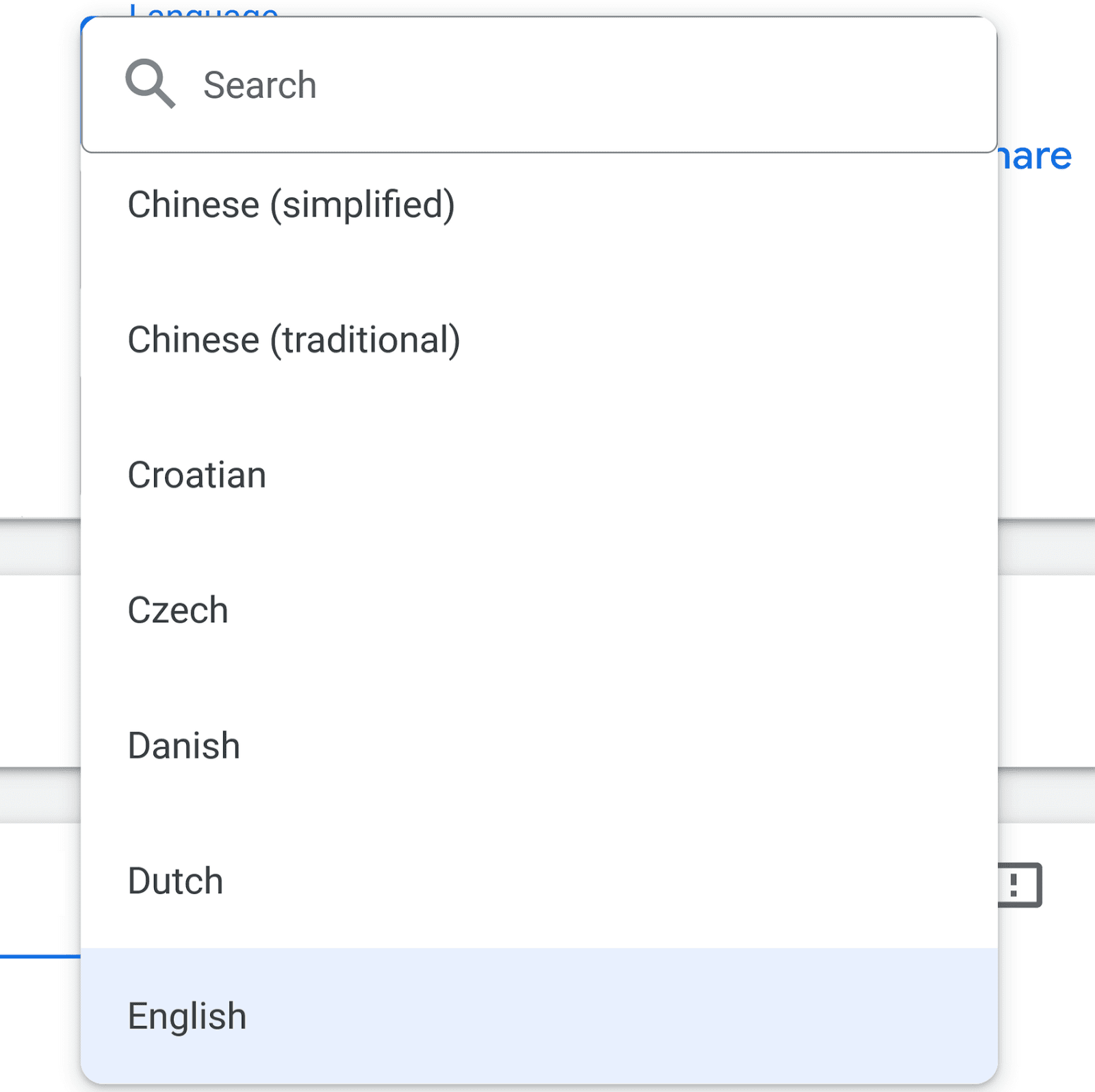
Select “Desktop,” “Mobile,” or “Tablet” when choosing your device.
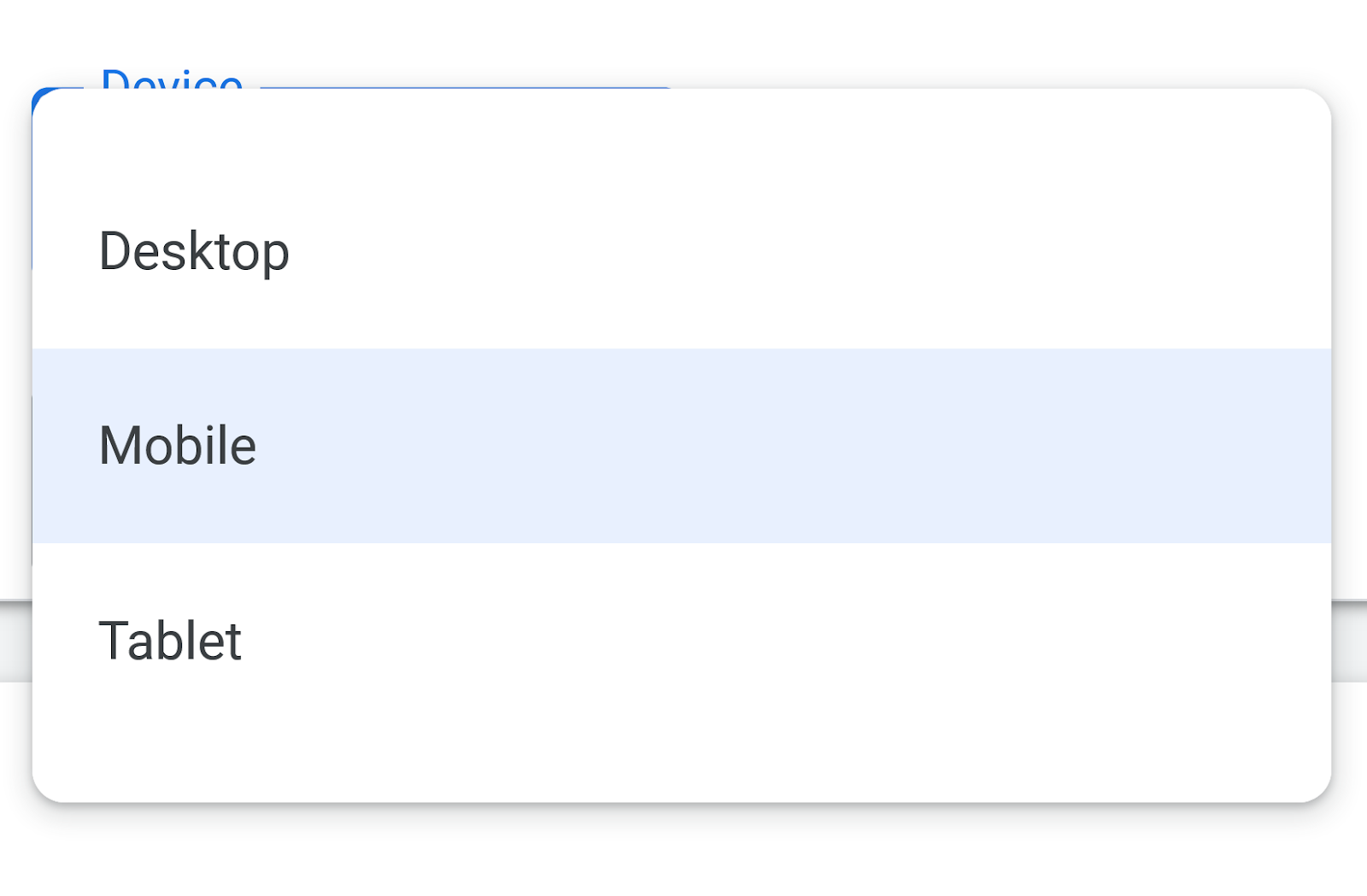
You’ll be able to view a SERP once you’ve selected each parameter.
View Results for Different Parameters
Your view will change if you change any of these parameters for a given SERP.
For example, here’s the SERP for the keyword “fine jewelry.” This is how the SERP displays in English on mobile devices in Washington, D.C.
We don’t have any ads running for this keyword, so we see “Your ad isn’t showing” above the display.
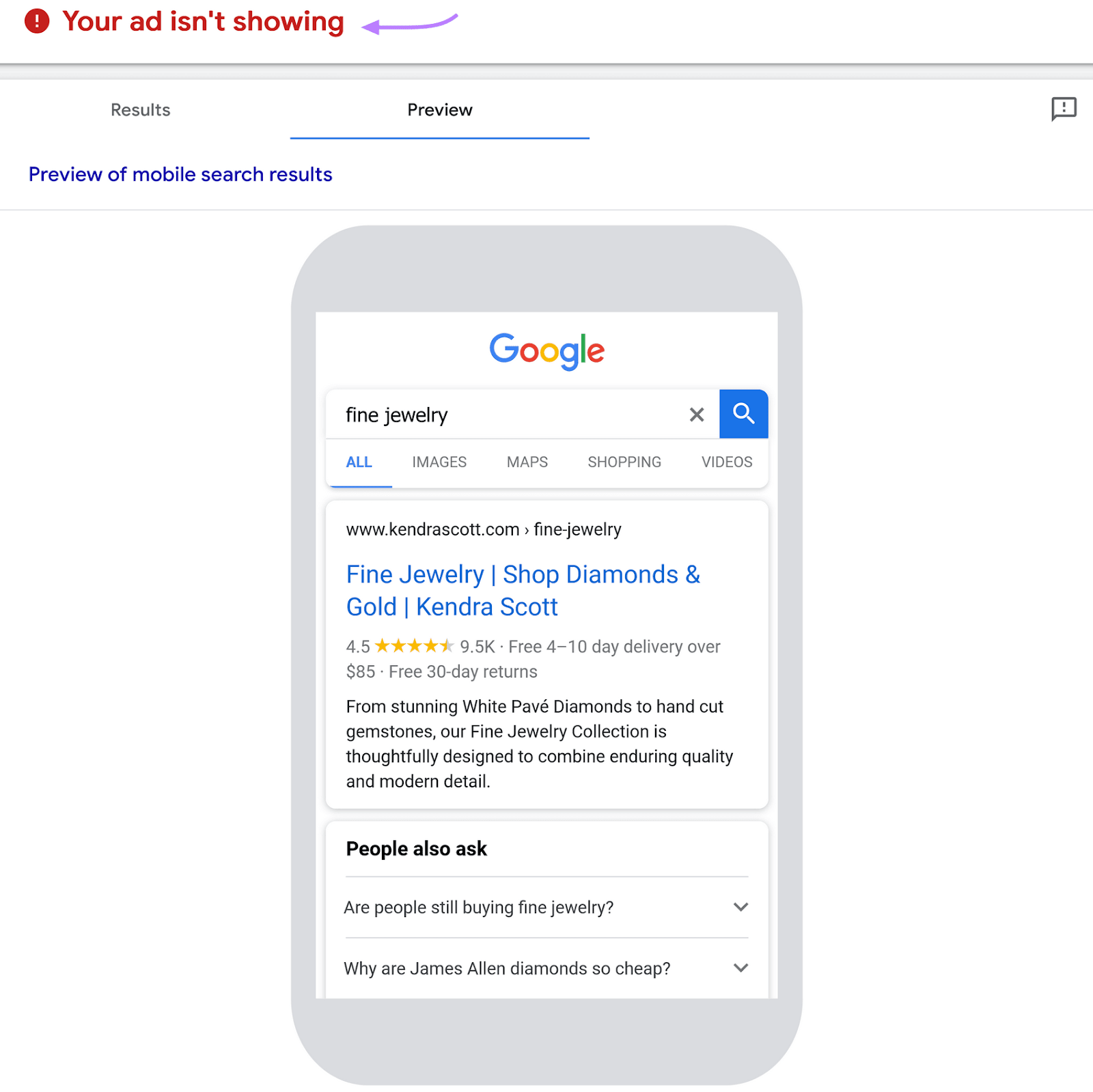
When we change our location to “Shanghai, China,” our language to “Chinese, Simplified,” and our device to “Desktop,” the SERP display for the same keyword changes.
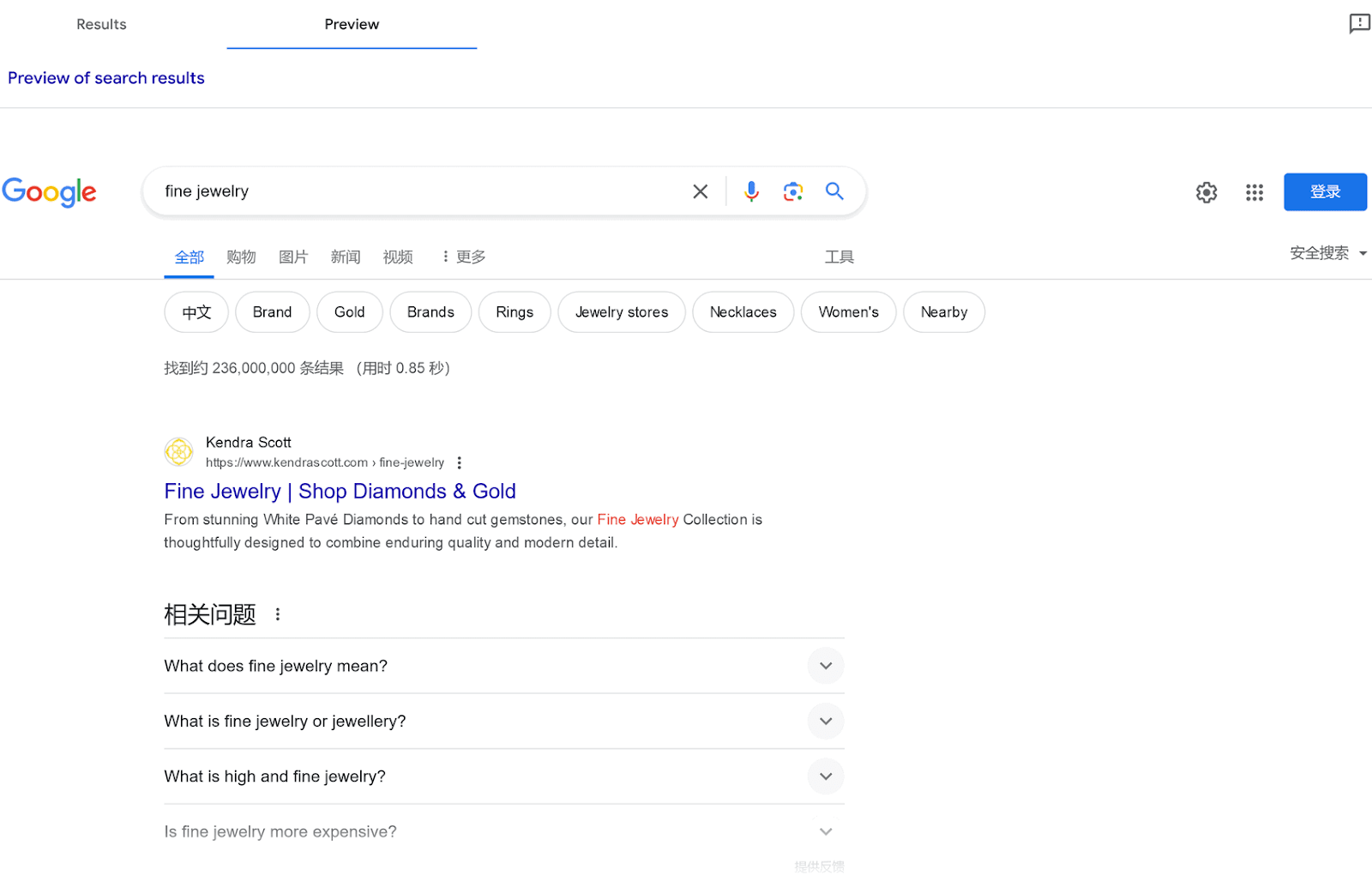
It changes when we search for “fine jewelry” again. But this time in Paris, France, with the language French, on tablet devices.
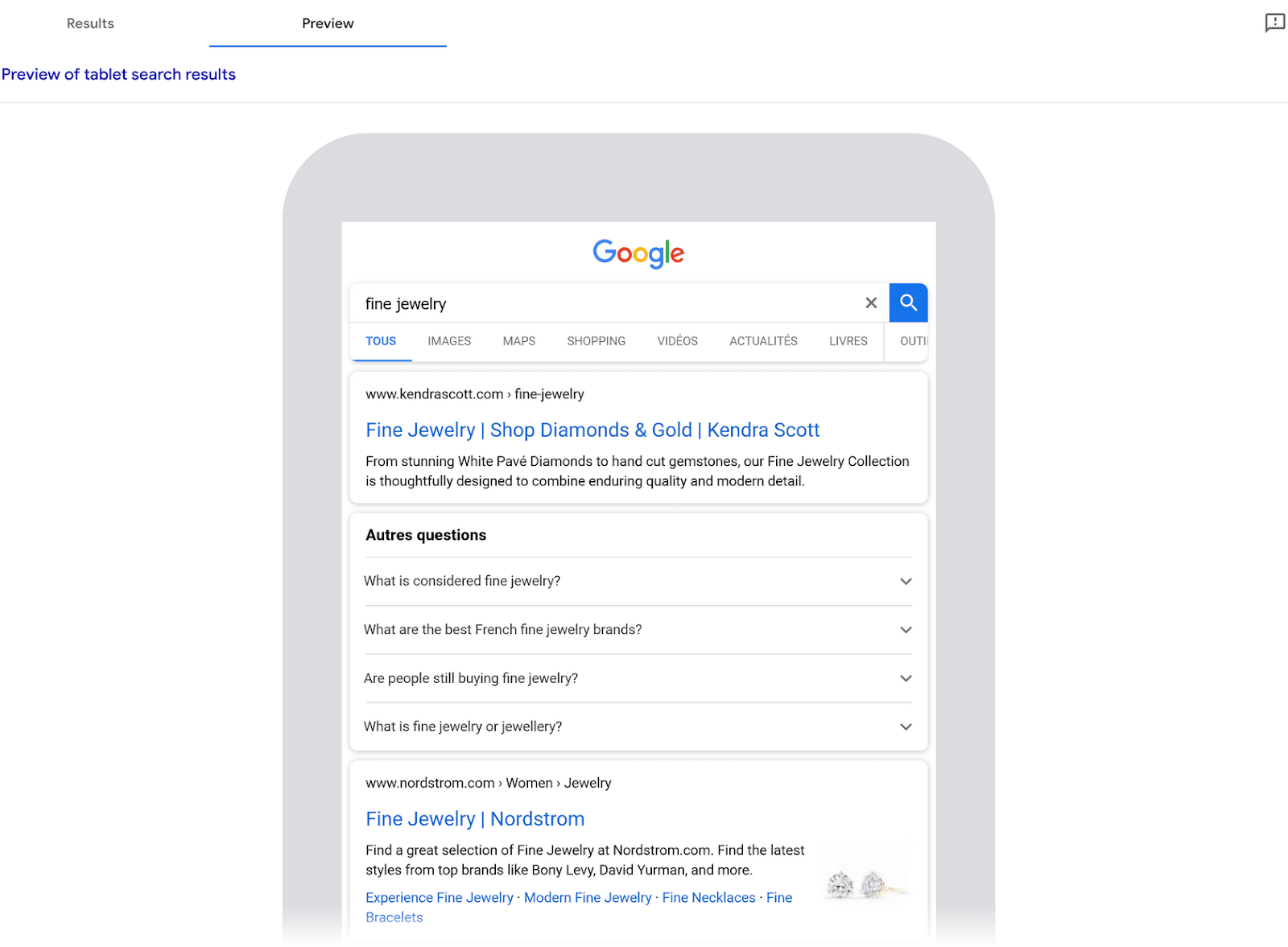
Diagnose Issues
We don’t bid for the keyword “fine jewelry,” as shown by these examples. If you see this error, click “Results” above the SERP display to see a diagnosis.
In this case, Google tells us our ads aren’t appearing because “fine jewelry” isn’t a keyword we’ve used in our campaigns.
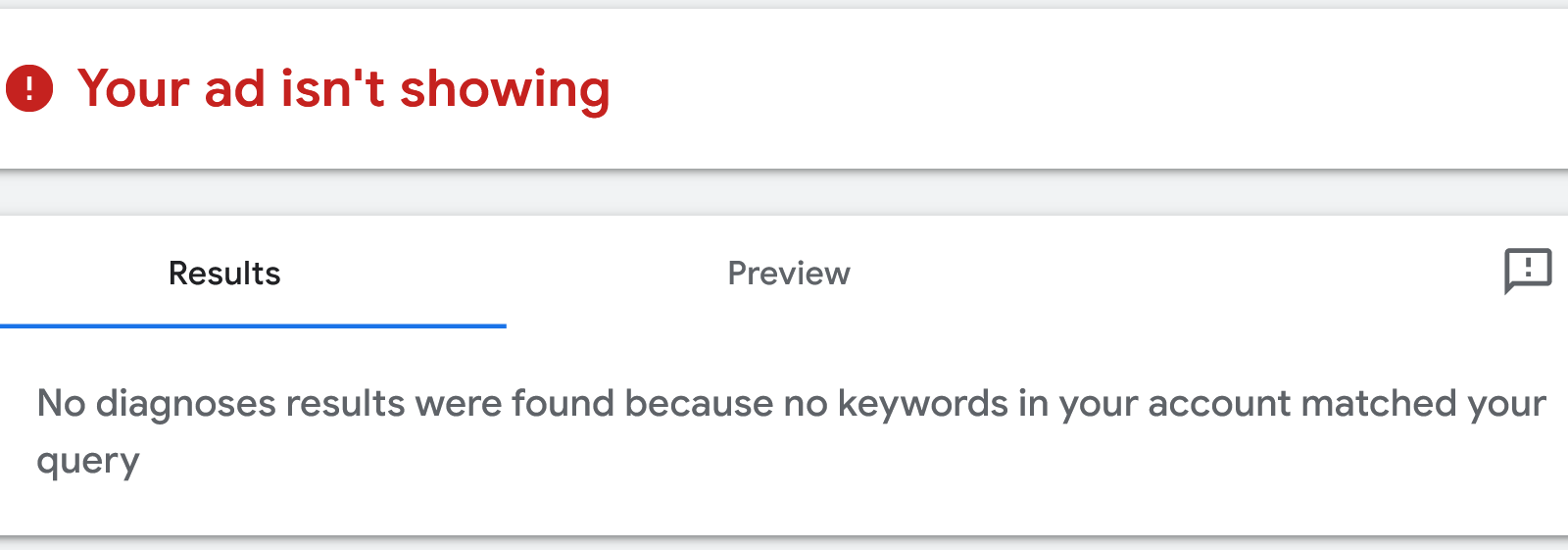
If your ad is showing, you’ll see “Your ad is showing” appear above the SERP display in green. Here’s an example from Semrush viewing our live ad for the keyword “google seo”:

Share Ad Previews
You don’t have to share access to your Google Ads account to let others see your ad preview. You can share any preview by clicking “Share” in the top right corner of the screen.
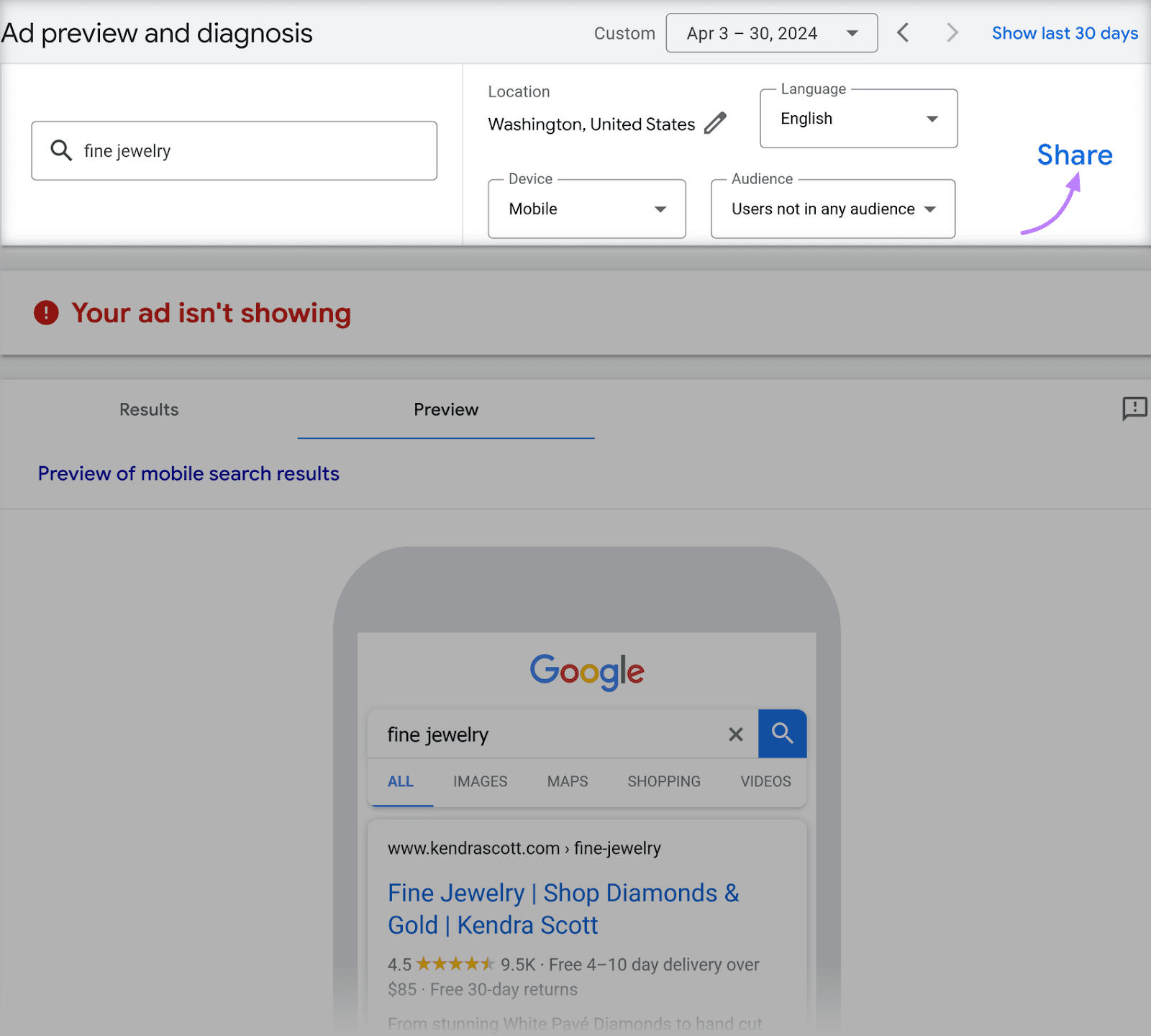
A dialogue box will open with instructions on sharing the SERP. Copy the link provided to share it with colleagues. It’ll warn you that your ad might not show if your daily budget has been depleted.
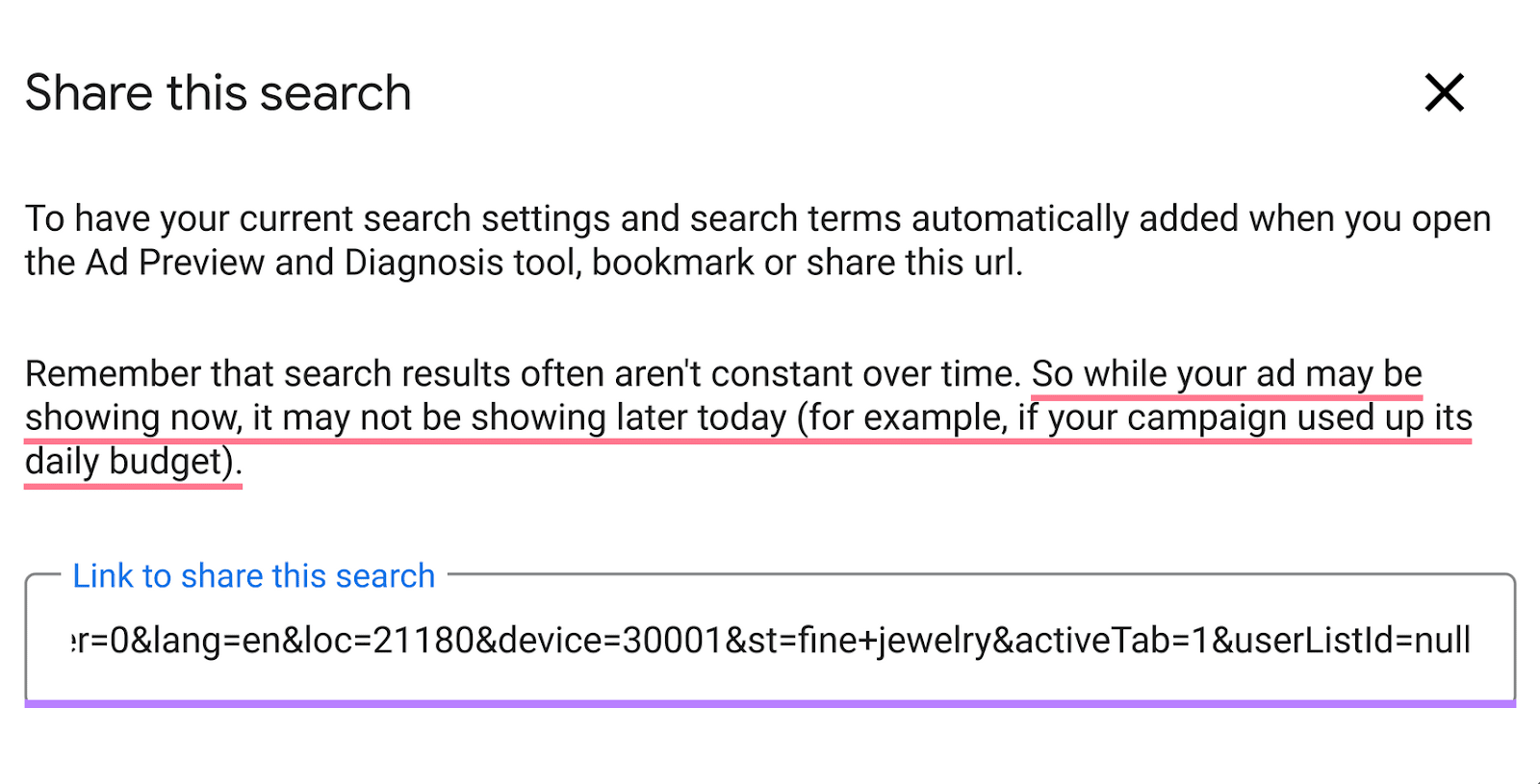
See a SERP Across Different Time Frames
See how a SERP has changed over time by adjusting the time frames in the upper right-hand corner of your screen. Click the **** box in that corner. Then click on “Start ****” and your **** options will appear:
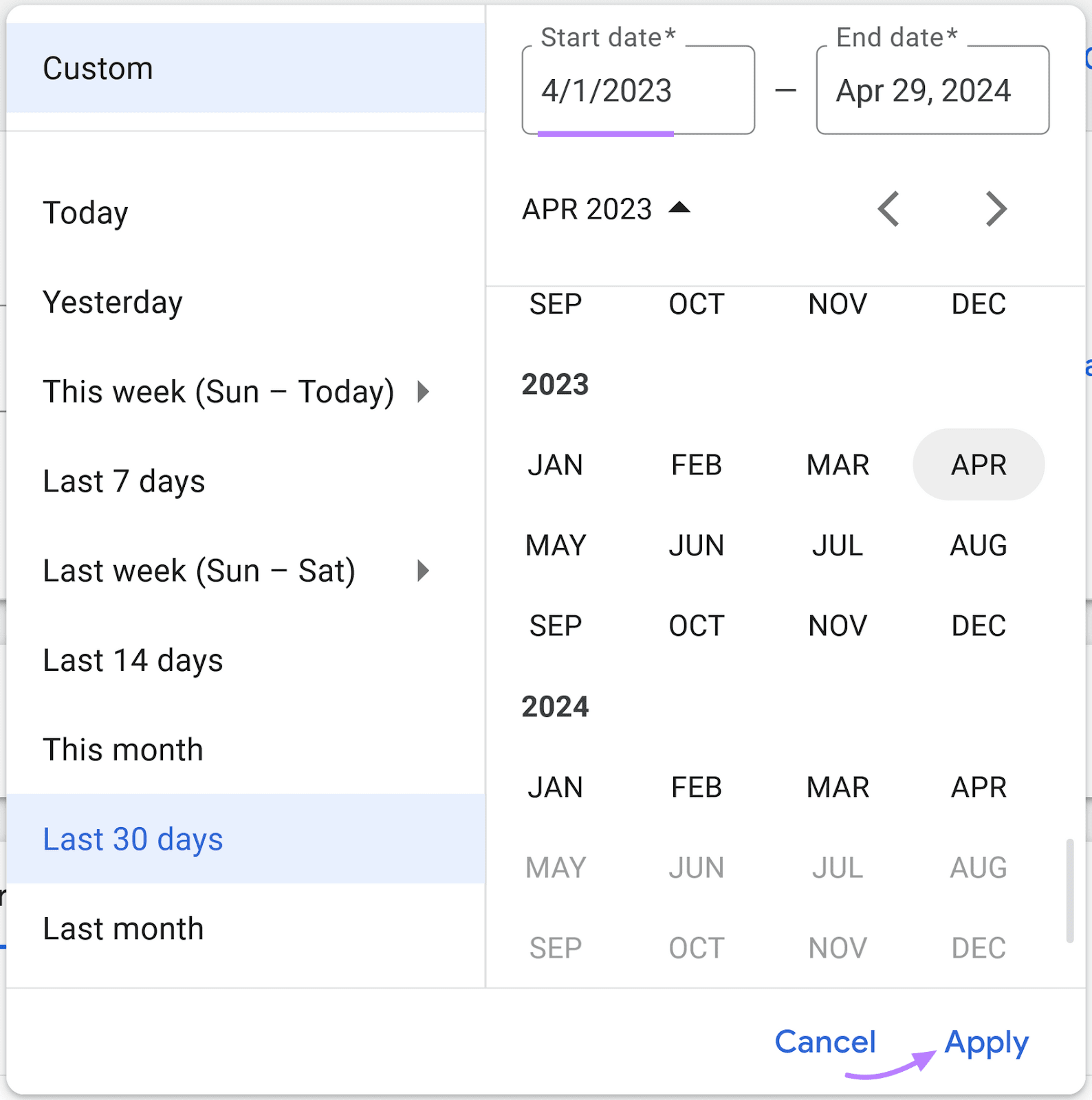
You can only view a SERP’s history for as long as your account has been open. So if you’ve had a Google Ads account for a year, you can view a SERP’s history for the past year.
Create Quality Ads That Perform
It’s important to feel confident that your ads appear as you want. And where you want.
Take this further by viewing your competitors’ ads, too. Without having to guess the keywords they bid for. But first, you’ll need to know which keywords they bid on.
Then, use Google’s Ad Preview and Diagnosis tool to see what their ads look like in different scenarios.
Semrush has advertising tools like Advertising Research and Ads History that help you research your competitors’ search ads. And the keywords they’re bidding on.
Let’s say you’re an online flower retailer looking for new keywords. You might want to see what keywords major U.S. competitor 1-800-Flowers.com bids for.
Here’s how:
First, open the Advertising Research tool and paste their domain in the search bar. Then, click “Search.”
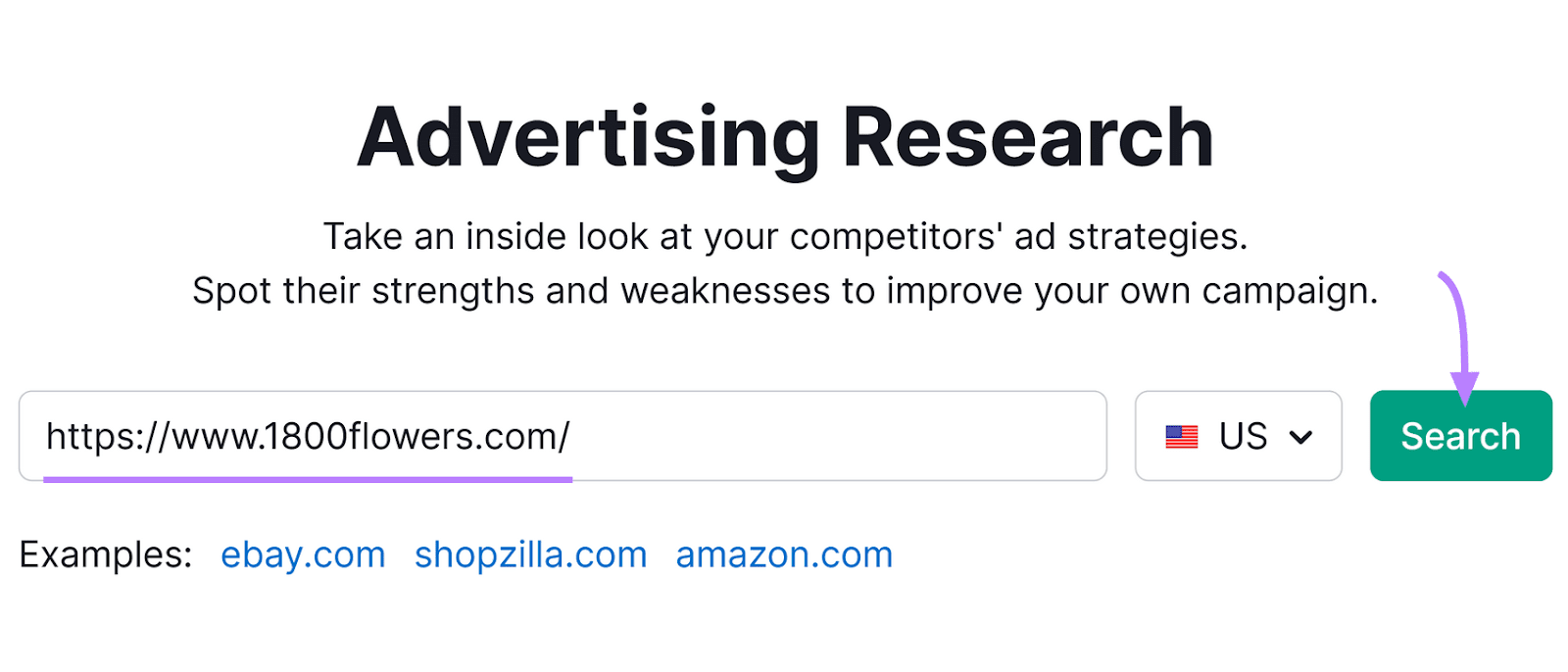
You’ll see a brief overview of their paid search strategy. Including the number of keywords they bid for and an estimate of the cost of their paid search traffic. To replicate 1-800-Flowers.com’s paid search strategy, you’d need around $204.5K a month.
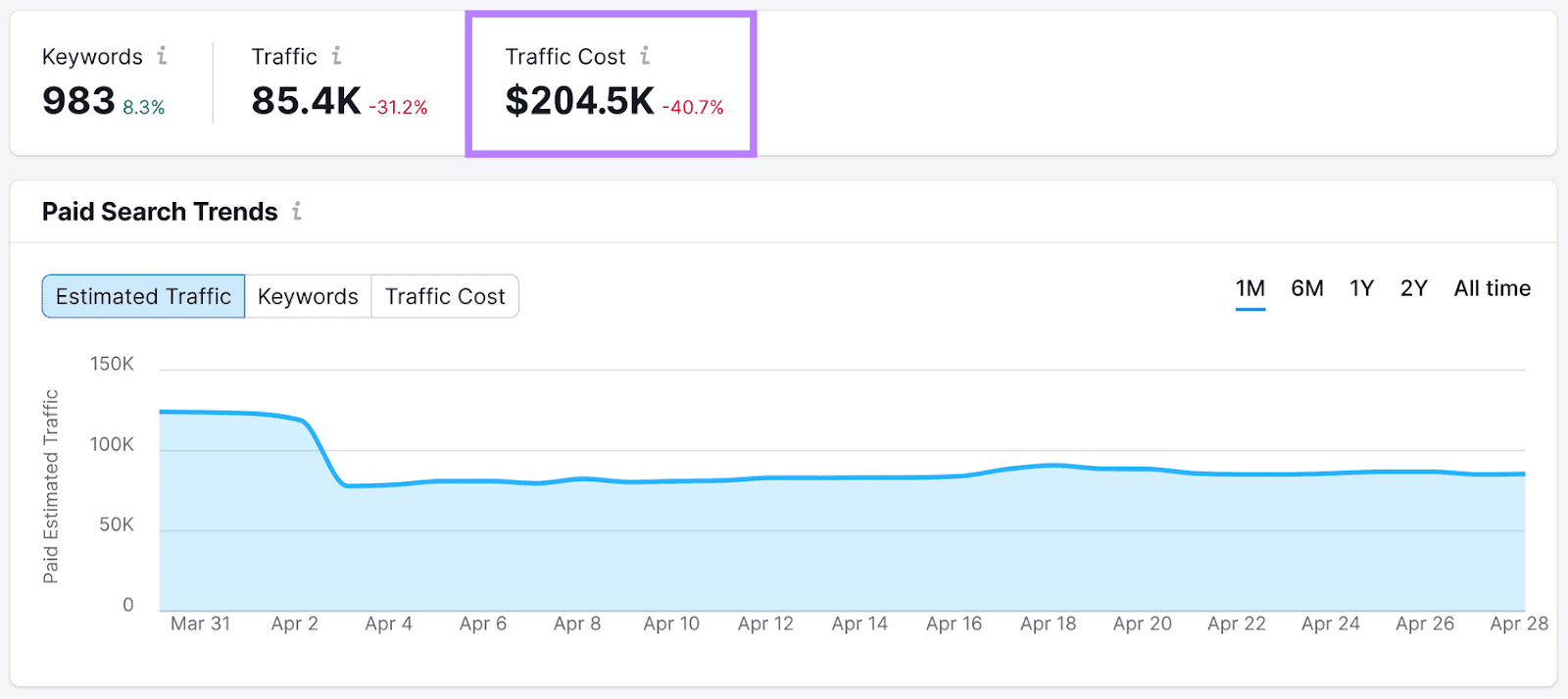
Scroll down the page to “Paid Search Positions” to see a complete list of keywords they’re targeting with their paid search ads.

To preview the ad creative they’re using for any given keyword, hover over the green button labeled “ad.” Here, we see their creative for “flowers” has general messaging about “Flowers For Every Occasion.”
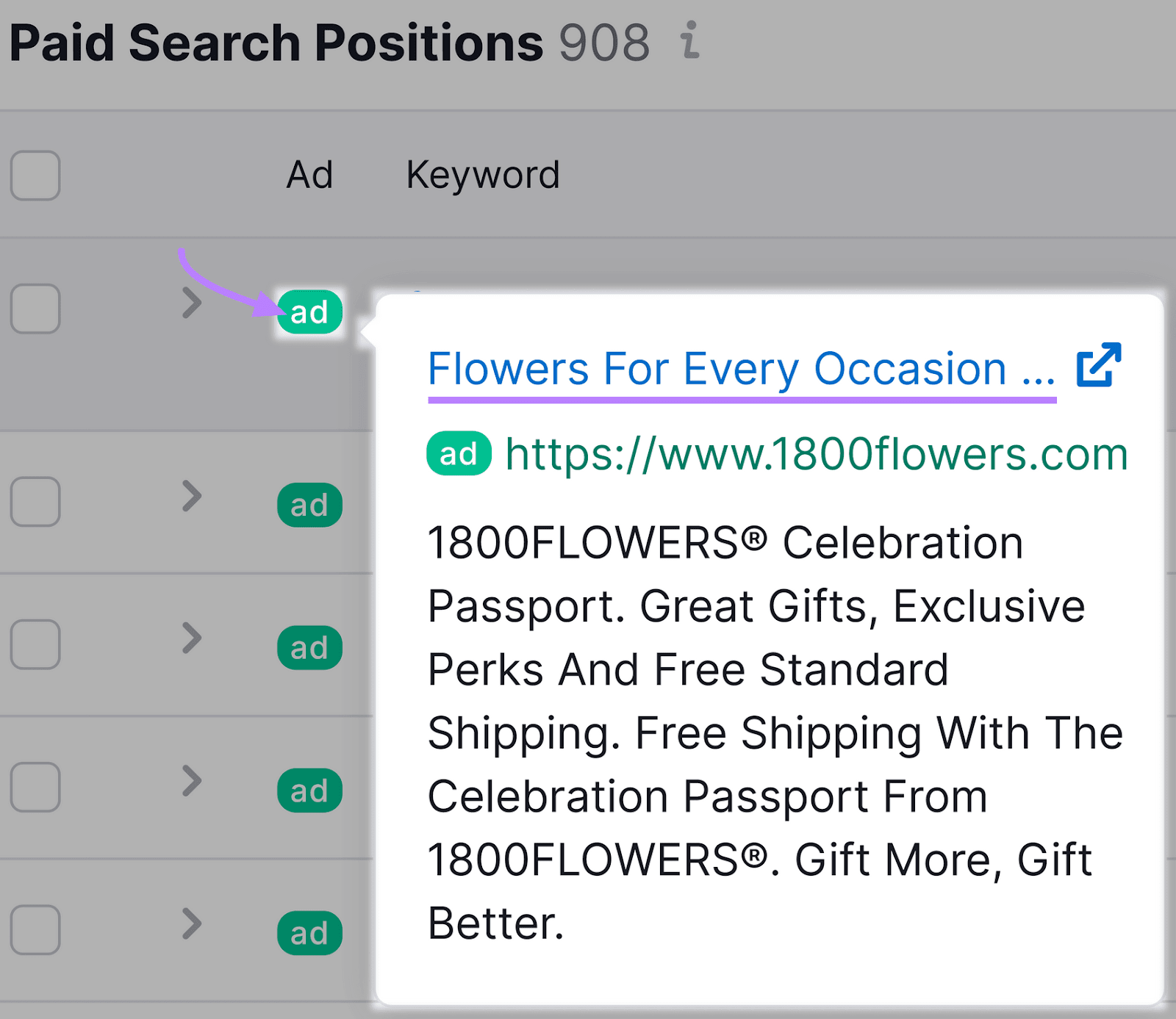
Click the arrow on the right-hand side of the keyword to see more insights.
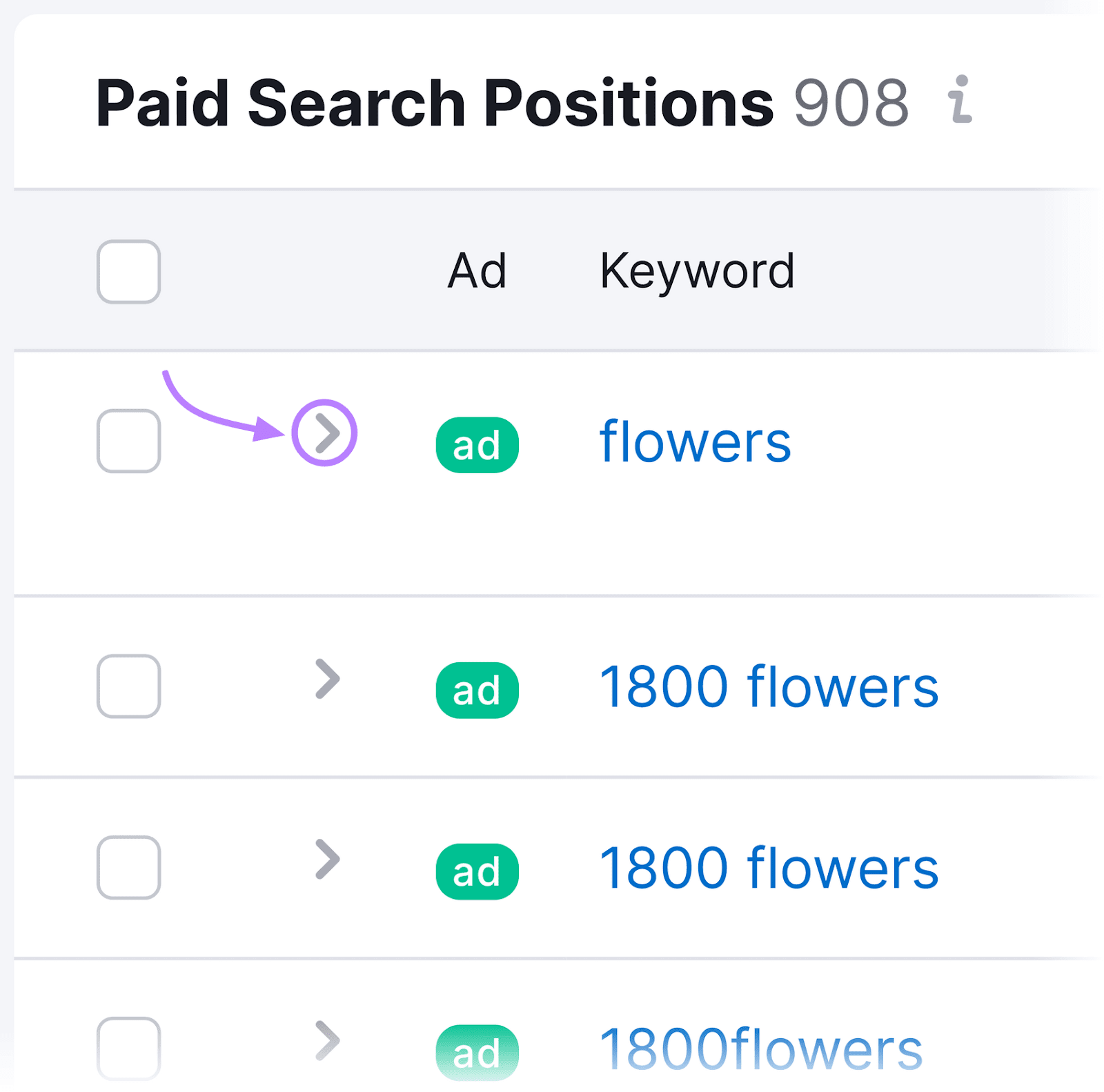
This example shows how 1-800-Flowers.com’s position has fluctuated for “flowers.” We also see a list of other competitors to analyze for even more keyword ideas.
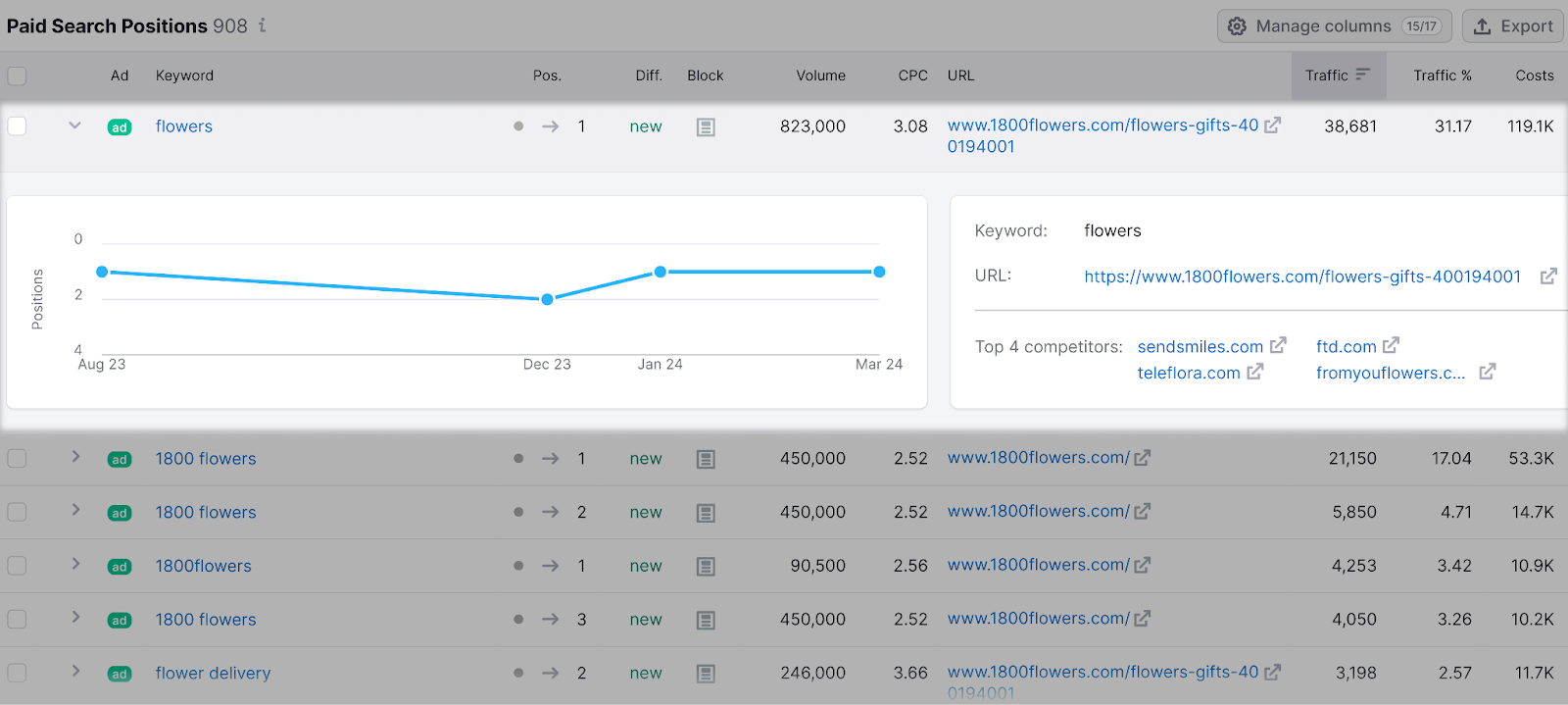
When analyzing a specific keyword in Advertising Research, click that keyword to discover other competitors bidding for the term. 1-800-Flowers.com bids on the term “flowers near me.” Click the hyperlinked keyword “flowers near me” to open the Ads History tool.
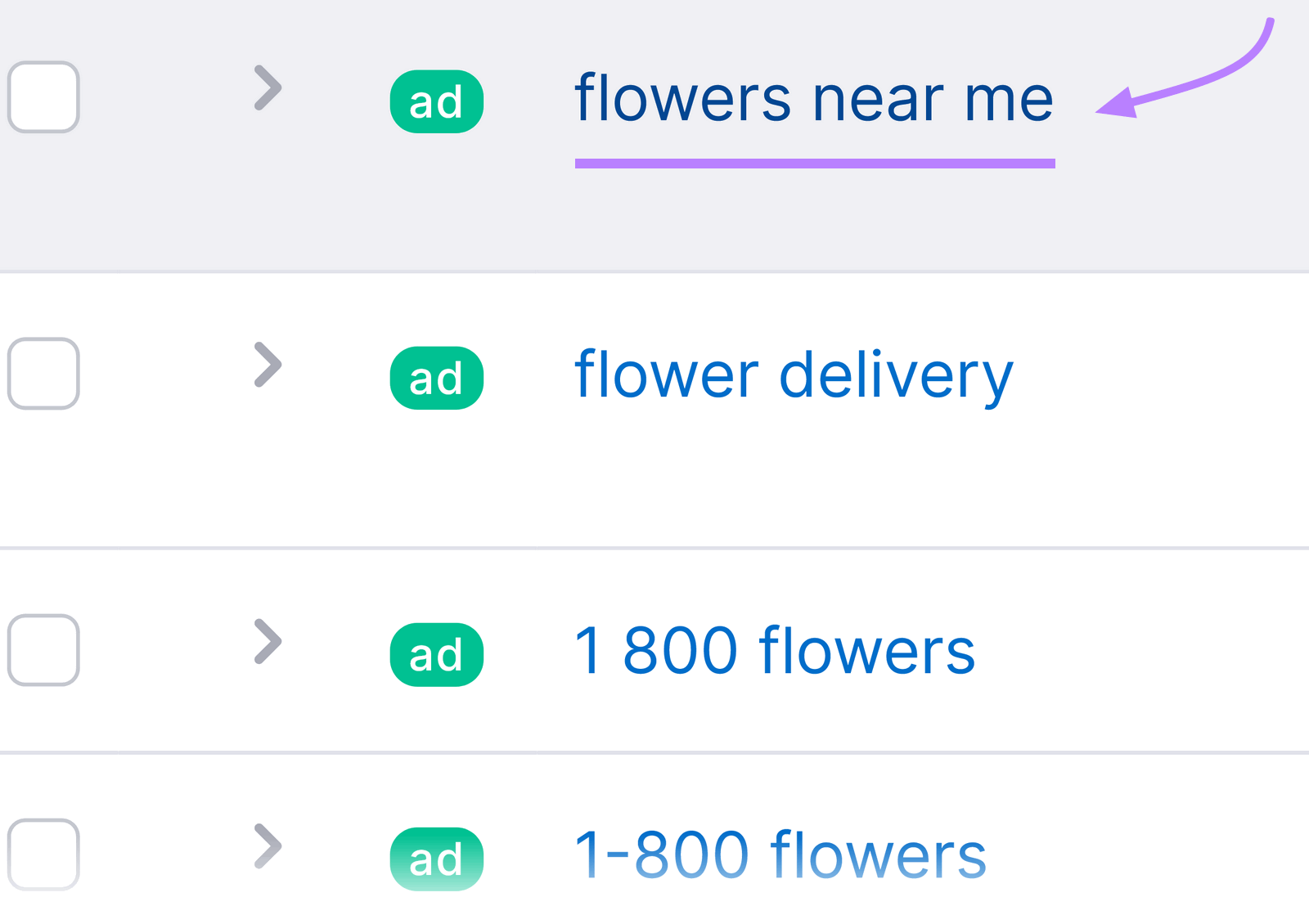
You’ll see a list of competitors that have bid for that keyword. And how they’ve ranked over the past 12 months.
For instance, fromyouflowers.com was in the number one position for “flowers near me” in June, October, January, and February.
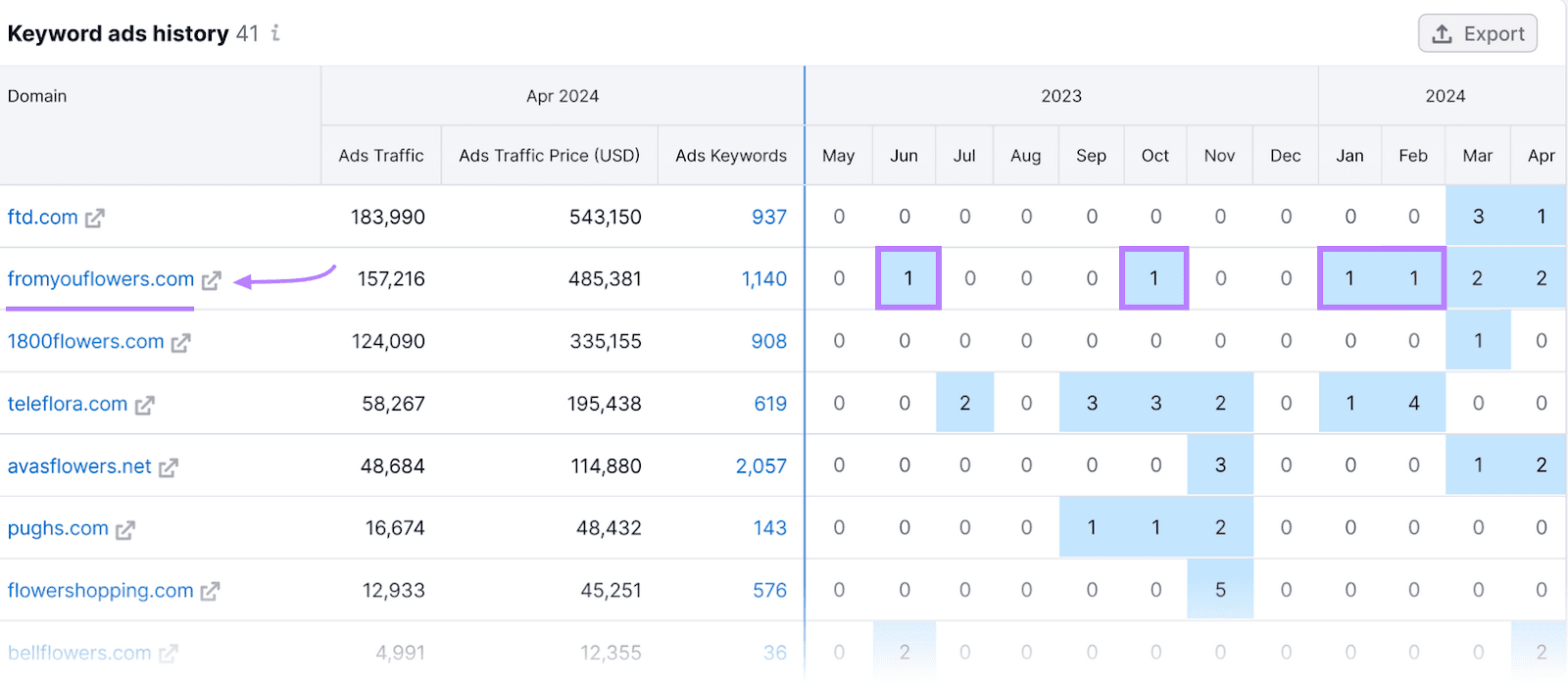
This tool can help provide insight into keyword seasonality. Or, when competitors ramp up their spend.
Click the hyperlinked number under “Ads Keywords” to return to the Advertising Research tool. You’ll see the complete list of keywords for which each competitor bids.
Use this information in combination with the Google Ad Preview and Diagnosis tool to see how ad creatives change in different countries, languages, and devices. You might get inspired for your next Google Ads campaign.
Google’s Ad Preview and Diagnosis tool does much more than just show you what your ad looks like. It segments your view by audience, device, and location. And it also helps you diagnose issues that might be blocking your ad from running.
Semrush’s Ads History and Advertising Research tools can help you evaluate keywords and work hand-in-hand with Google’s tool to view the related SERPs.
Sign up for a free Semrush trial today to see more competitor ad previews. And, for more insight into which keywords might be an essential part of your paid search ad strategy.
Source link : Semrush.com
